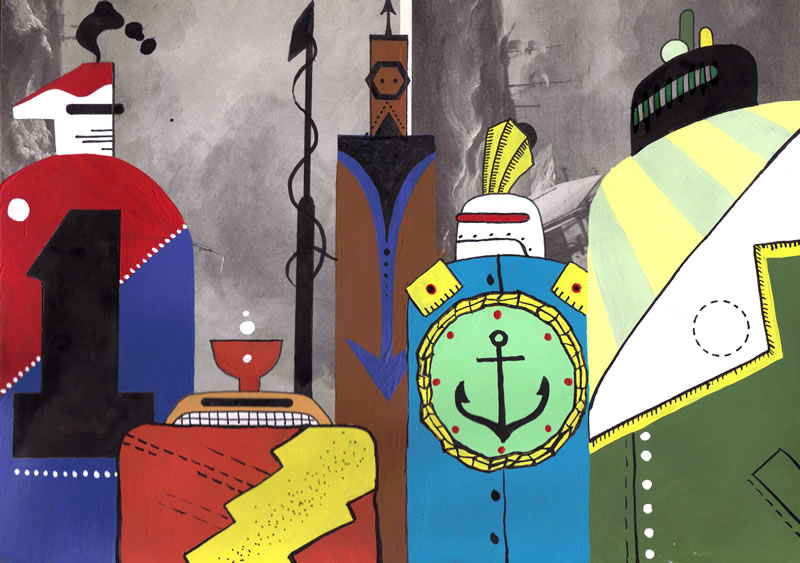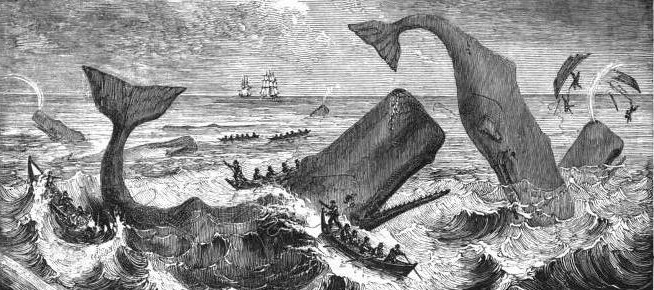9/24/21, 7:32pm
29
In the light of day, and with a fair prospect of breakfast before him, Ishmael gets a better look at his fellow lodgers at the Spouter Inn, some of whom he saw arriving the night previous. In the text of MD Ishmael registers several precise physical characteristics of these specimen “whalemen” in his description – “a brown and brawny company, with bosky beards; an unshorn, shaggy set, all wearing monkey jackets for morning gowns.” These attributes are ellided out of MK’s isolated line from “Breakfast” which serves the title of his illustration, whose matter instead is a list of the whalemen’s ranks on the hierarchy of the whaleship or what form of labor they bring to the fishery: “They were nearly all whalemen; chief mates, and second mates, and third mates, and sea carpenters, and sea coopers, and sea blacksmiths, and harpooneers, and ship keepers.”
Notably absent from MK’s illustration of this company of whalemen upon the landscape-oriented canvas is the cylindrical peglike figure of the landlubber. Workers in whaling are differently drawn, imbued with either the elemental mediums native to their labor (primarily water, fire, and air) or the tools of their various trades. One of figures on this canvas is recognizable, the broadest of the 5 standing to the far right of the frame. It’s Bulkington (from 14); notable among the minor differences in his reappearance on this canvas: his brickwork cofferdam of a chest beneath his unbuttoned pea-green monkey jacket is painted over in pale blue and yellow stripes, his fluid-blue visor-eye has been replaced with a green-grey balene-band. The figure standing on the far left of the canvas is clearly the “chief mate” (aka first mate), as there’s a large black 1 painted on his red/blue silough-shaped body; even its head is drawn in the shape of a large blocked number one, colored white: three hashmarks about a mouth, a slouch of red for a cap, with a furl of ink black eddying from the top of it. Whereas the coffer-dam chest of Bulkington walls up water within (as previously shown in the depths of the visor-eye featured in his individual portrait), the silough-bodied chief mate keeps the air in or rather keeps it out, the excess of what it can’t contain – whether absence or presence of a certain air – excreting in the form of black cloud that briefly forms the shape of a whale before breaking apart and rejoining the sky.
The tallest figure, standing center canvas and occupying its full height is one of the other mates, second or third: I’m inclined to think third. Standing next to this figure, which is colored mostly brown, is a black silhouetted lance, its line spiraling around its shaft and disappearing behind the figure’s back. The figure’s proximity to the lance might represent a recent promotion since the implement whose use was reserved for those aboard the whaleboats deserving the honor and glory of the kill (if not the dart that secured it) – the lance – is not the shape of the tool emblazoned in blue on its body and protruding like a finial out of the top of its tubular head – that’s a harpoon. I read a story in the beady eyes of this tall illustrated whaleman where a long-darter of whales finally ships out a mate. Like the newly minted mate the squat blacksmith to its one side is imbued with the icons of its trade: a squared off slag red body is cut across by a yellow lightning bolt, flecked black. Upon the flat terracotta head featuring a double row of white block teeth and a black visor-eye is a chalice-shaped vessel with a row of white bubbles rising from its middle, like a quench. The figure standing to the other side of the third mate stands taller than the blacksmith but shorter than the rest; it’s draped in a powder blue coat with golden, fringed epaulets, pinned large about its middle is an emblem: a circle of golden cordage frames a black anchor against a field of seafoam green. The rounded head of this figure is colored white but a pattern of lines and circles gives it the appearance of riveted metal plates cut across by a red visor-eye; atop its head is a golden fin or frond resembling the horn of a gramophone or an ear trumpet. This would be the ship-keeper, who bore the responsibility for the ship’s movements and communications between the crew when the captain was away. The anchor emblem on the figure’s chest is nearly identical to the one spouted before the face of that right whale of a captain who Ishmael foresees ordering him “GET!” when he ships (in 4); it signals the singularity in the hierarchy of the whaleship’s power structure whereby it must distribute itself incrementally down the ladder of command, with the captain on top, whose “complete dominion” can transfer and indeed does frequently transfer to another, even one upon its lowest rung.
Presumably, Ishmael would’ve discovered after a certain brief period of casual conversation and repeated meetings the respective positions and occupations of the various whaleman about the Spouter Inn and is not claiming to be able to distinguish at sight their positions in the whaleship’s hierarchy and its division of labor when he sees them before his first breakfast in New Bedford. MK is in the opposite position of having to make the duties and specialized labors of the whaleman visible. Of course, there is no real urgency of his doing so here; he might have illustrated any number of charming lines for this page. I would suggest he chose this moment as a sort of practice run along the rungs of the whaleship’s hierarchy for his portraits to come of the main cast of “knights and squires,” tradesmen, servants, and men-before-the-mast comprising the crew of the Pequod. Before we even know that ship to be hiring crew, MK is working out how to conjure them.

MOBY-DICK, Page 029
Title: They were nearly all whalemen; chief mates, and second mates, and third mates, and sea carpenters, and sea coopers, and sea blacksmiths, and harpooneers, and ship keepers…
(11 inches by 8 inches; acrylic paint and ink on found paper; September 4, 2009)
